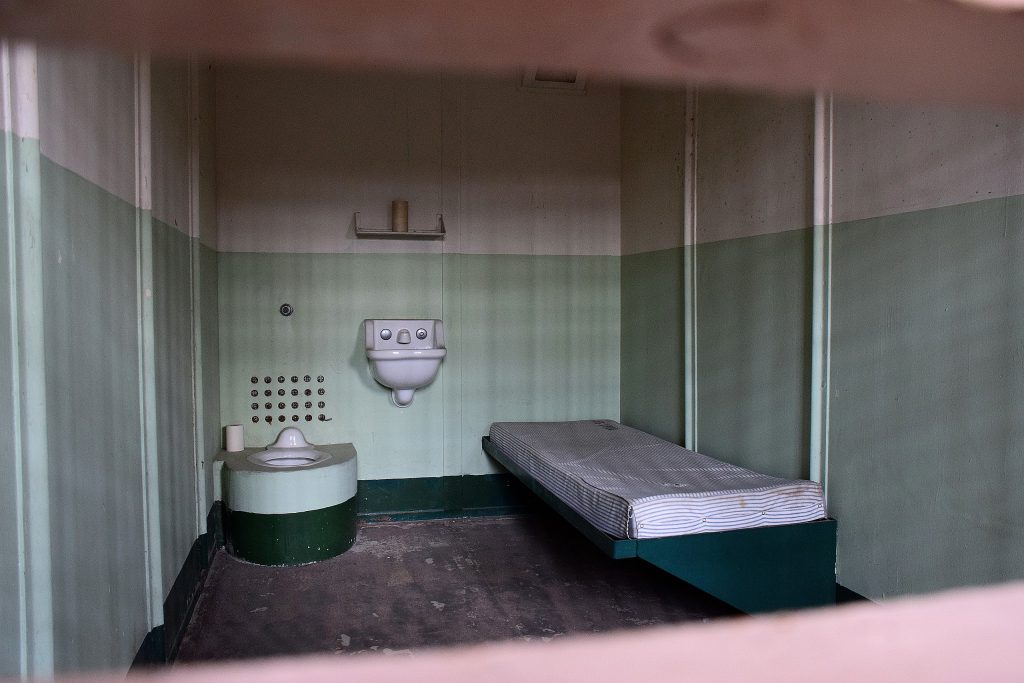
28 Jun It’s Not The Ritz: Attitudes About Prison Conditions In America
On May 17, a judge remanded Young Thug, a rap artist from Georgia, whose legal name is Jeffrey Williams, to pretrial custody after a court hearing in Atlanta, Georgia. Allegedly, the artist co-founded the “Young Slime Life” gang, which has allegedly been responsible for numerous crimes, including possibly 50 or so murders, in the area. The judge found him to be flight risk and placed him in pretrial detention while he considered the bond he will order.
He was remanded to the neighboring Cobb County Jail. The Cobb County Sheriff’s Department, which runs the jail, chose to segregate Williams from the general population. And, as regularly occurs in many institutions, that meant officials placed him in solitary confinement. Williams’ lawyer immediately went to the press, declaring his conditions of detention to be “inhumane” and “dungeon-like.”
The sheriff seemingly decided to call the lawyer’s “bluff” about the conditions Williams faced. He invited a TV reporter to tour the unit in which Williams was interned. According to the report, Williams was in a windowless, concrete cell. He was one of seven men detained in the unit. The reporter could see, but not talk to, Williams. Williams’ lawyer also says that officials won’t let him bathe. (I have found no reports to confirm that, which would be a major civil-rights issue.)
These are the prison conditions Williams finds himself in. And they’re also the ones he claims are “inhumane” and “dungeon-like.” Government officials unsurprisingly disagree. As one Cobb County official told reporters, “[i]t’s not the Ritz-Carlton.” But these are prison conditions roughly two million people encounter everyday in the U.S. And Williams’ comments about them should make us think about how we think about prison conditions.
Prison conditions depend a lot on where you bunk.
As I cited in one of my previous articles, there are more than 4,500 incarceration facilities in the U.S. And that statistic doesn’t even include youth and immigrant detention centers. It’s not easy to generalize about so many institutions. Some things are clear though. For instance, the longer someone spends in incarceration, the more likely they are to return to custody. Another factor deals with the fact that concerns over prison conditions vary based on who is incarcerated.
One cannot say that the amount of money a jurisdiction spends on incarceration guarantees better conditions. New York spends an enormous amount of money on prisons. Yet it is still home to Rikers Island, considered by some to be the worst facility in the world. Currently, Rikers remains on the verge of falling into a federal receivership. On the other hand, if you don’t spend much, you don’t get much. Alabama has very high rates of deaths and sexual assaults while in custody. But Alabama officials — or, more precisely, their detainees — get what they (don’t) pay for.
Regardless of where you find yourself, however, it is a fact that 95% of people who go to prison will be released at some point. And studies also make it clear that prison conditions tend to be better in jurisdictions where officials focus more on preparing people for their eventual release.
The comparisons about prison conditions often go too far.
Young Thug’s lawyer went a bit far comparing his detention situation to a dungeon. Bible readers know that prison conditions have advanced greatly since the Apostle Paul was imprisoned at Phillipi, stripped of his clothing, beaten with rods and then thrown into “the innermost cell” with his feet in the stocks. Such practices today would likely be found unconstitutional, not to mention the intense use of manpower involved in leg-irons as opposed to solitary confinement. There also might be some trepidation regarding the way Paul was freed from the irons.
Actual dungeon conditions were, if anything, worse than what St. Paul endured. Dungeons in the basements of castles. The prisoners, men, women and children, were chained in fetid conditions with raw sewer and rodents. It is doubtful that Cobb County, or any American jurisdiction, could find people willing to work in such a place. If the TV reporter had found the rapper chained in a cellar with sewerage dripping on him and rats crawling over him, I’m sure it would have made international news, to say the least.
But dramatic claims in the media don’t mean prison conditions are humane.
I do not mean to make light of these charges. Discussions of prison conditions often involve hyperbole. However, life in prison is dismal. One of my most vivid memories involves walking from the bright, wood paneled courtroom into a gray and dark green corridor. This overwhelming drabness colored my existence for more than a year. The Vera Institute has attempted to make the public aware that prison life involves degrading treatment, inhumane conditions and abusive interactions.
A modern prisoner gets stripped on entry. Then they receive a disinfectant shower and endure their first cavity search. They may have to remove all or most jewelry and have certain hair shaved. They receive a suit or two of clothes and undergarments that are the same color as those worn by all the other people in the unit. And they will henceforth be referred to only by their last name. From that point on, they may not see natural light for days or weeks.
I’m always surprised when I hear bad food cited as the hallmark of prison heartlessness. Millions of underprivileged people live on bland, tasteless rations. However, imagine living with hundreds of other people dressed in the same dark green (or orange) suit as you for day after day after day. That is how someone loses their humanity.

Most of the time, the narrative goes, it’s only cruel if it happens to those you like.
When Jussie Smollett was sentenced to 150 days in jail, which could have triggered violence in Chicago, there was outrage amongst the acting community. Many expressed concerns about the jail conditions like those expressed about Williams. In both of their cases they went into protective custody, which often is, in fact, solitary confinement (regardless of what the jailers call it.).
Chicago’s conditions for Smollett would not (he was released after one day) have been as onerous as those Young Thug has endured. The plan for Smollett included use of an exercise area and telephone privileges. However, the “theory” for both men was and is separation from any contact with other prisoners for fear of their being harmed.
Celebrity incarceration turns into a county jailer’s plight.
These “celebrity” incarcerations highlight some of the basic problems of protective custody or any kind of higher-intensity incarceration or detention. The “system” is not only concerned with protecting the incarcerated person but also protecting itself. If harm should come to the notorious, impacted individual, the glare of the public spotlight would be especially bright.
In the case of Williams, Cobb County’s procedure is understandable. While Young Thug is an accomplished rap artist and, from a correctional standpoint, a pretrial detainee, the allegations against him are hideous. His gang activity allegedly includes something like 50 murders. That alone is 50 reasons for rivals to stick a shiv in his back.
His case presents a larger question of the proper range of protective custody options for persons in one of the nation’s largest and fastest growing metropolitan areas. His attorney’s time might be best spent crafting a home detention alternative for him. Still that may not even be the best circumstance for his safety. Ultimately, Cook County (Chicago) appeared ready to opt for protective custody.
After being found guilty, Smollett protested his guilt. He, his lawyers, family and supporters raised concerns based on his race and sexual orientation. Nevertheless, given his five-month sentence and the nonviolent nature of his offense, Smollett would be considered a “short” stay. And, if properly classified, he would be housed with others considered to have a low potential for violence and a strong disincentive to infract the rules.
Even some of the biggest “rule of law” supporters have discovered the perils of the lockup.
Hollywood glitterati aren’t the only ones decrying incarceration these days. In the wake of the Jan. 6 riot at the Capitol, the far-right MAGA community started decrying the detention and possible sentencing of their heroes. On Sept. 18, 2021, they returned to the Capitol for a “Justice for J6” rally to protest the “hundreds of detainees facing charges from the riot.”
However, like the claims of election fraud, these claims quickly fell apart. By Sept. 2021, out of 600 persons arrested for charges stemming from the riot, only 40 remained in pre-trial detention. Those that remained were largely facing either assault on police, disrupting government proceedings or federal property destruction charges, or some combination thereof.
A general thumbnail sketch of the rioters shows them to be about 90% white and mostly, but not all, men over the age of 40. For the most part they were employed and some of them were even wealthy. Despite the violence of the day, most left the scene and had to be “recaptured” after the event.
The So-Called QAnon Shaman
Jacob Chansley, the so-called QAnon shaman, is serving a 41-month sentence. He pleaded guilty to entering the capital with a weapon, namely the spear with the American flag he carried and for storming the Senate chamber, thus interfering with a governmental proceeding. He served 317 days of pretrial detainment, mostly in solitary confinement due to COVID-19, in the Alexandria, Virginia, jail where officials eventually met his special dietary requests. Chansely is now serving his sentence at FCI Safford in Arizona after his lawyers requested a transfer to a facility closer to his mother.
A rioter of note in my locality, Patrick Edward MacCaughey, III, of toney Ridgefield, Connecticut, participated in the riot by stealing a police riot shield and beating a trapped Metro D.C. policeman with it. Arrested in South Salem, New York, in late Jan. 2021, the judge initially refused to grant him bail. MacCaughey was freed in early May 2021, after his parents got him a good criminal lawyer, who proffered evidence that MacCaughey eventually helped free the officer from the door, and his parents put up a $1,000,000 bond. He remains free on house arrest in the Connecticut woods as he awaits trial.
A Heavy Metal Proud Boy
Heavy Metal guitarist and Proud Boy member Jon Schaffer faced two months of detention in an Indiana jail where, he alleges, people “hurled” feces and urine, along with death threats, at him. His lawyer described this as a “horrible, horrible situation.” And officials subsequently moved him to a Washington, D.C., jail.
After pleading guilty to the disruption charges, he remains out on bail and is reportedly cooperating federal authorities. He faces a recommended 3.5-to-4.5-year prison sentence, depending upon the results of his cooperation. The D.C. Attorney-General is, however, suing him civilly for a part of the costs incurred by the district in the riot.
A Wealthy Blonde Woman
Jenna Ryan, the Dallas area real estate lady who flew to the riot by private jet, loudly proclaimed on social media after her arrest that she would serve no prison time. Her reason? Because of her “white skin” and “blonde hair.” Any justice-impacted person would have advised against such presentence prognostication on the web.
Indeed, a judge sentenced Ryan in Nov. 2021 to 60 days in a Texas federal facility. She faced COVID-19 protocols and likened her prison stay to life in “a third-world country” (but never cited a specific one). Ryan complained of suffering chilly temperatures and deprivation of “basic human rights” such as sunlight and telephone. She stated, though, that she met some good people in prison. Since her release, she has returned to selling real estate.

The Jan. 6 defendants’ prison conditions could have led to change. But they didn’t.
The plight of pretrial detainee Herman Diaz contrasts sharply with Ms. Ryan’s experience. Diaz was awaiting trial for charges of menacing and robbery. He was not a Capitol rioter; rather, he was a Rikers Island detainee. In March of this year, as news of riot chargers still simmered, Diaz, 52 years old, stumbled out of a Rikers Taylor unit restroom, grabbing his throat and falling to the floor. His fellow incarcerated people rushed to his aid as there were no correctional personnel present. Rikers officials claim Diaz died at the jail infirmary, having choked to death an orange slice.
Last week a 20-year-old pretrial detainee named Emmanuel Sullivan was found dead in his bunk at the Robert N. Davoren Center on Rikers. Authorities have yet to determine his cause of death. Sullivan was the sixth person to die in custody at Rikers so far in 2022. And earlier this month, that list rose to seven. Since the first arrests for the Jan. 6 riot, over 20 persons have died within the walls at Rikers. But you hear very little, if anything, about the conditions leading to those deaths from the folks who decried the treatment of the Jan. 6 defendants.
When we talk of poor prison conditions, what do we mean?
Many may look at the contrast of Rikers detainees with Jan. 6 rioters as a false one, but I differ. When we juxtapose the fates of two allegedly violent individuals — MacCaughey, who reclines in his parents’ Ridgefield home with an ugly, pernicious bracelet on his ankle, against Mr. Sullivan, in a morgue with a toe tag — one gets a picture of the divergent conditions a bail bond can bring.
Young Thug, the celebrated rap artist and alleged gang murderer, is unlikely to choke to death on an orange in the arms of his incarcerated peers and certain to find is face on the evening news, and calls for an inquiry, if he does. Prison is not and never will be like the Ritz Carlton. But the discussion of prison conditions in this high-profile cases could lead to meaningful change if that’s where these individuals took the conversation. So far, they haven’t.

